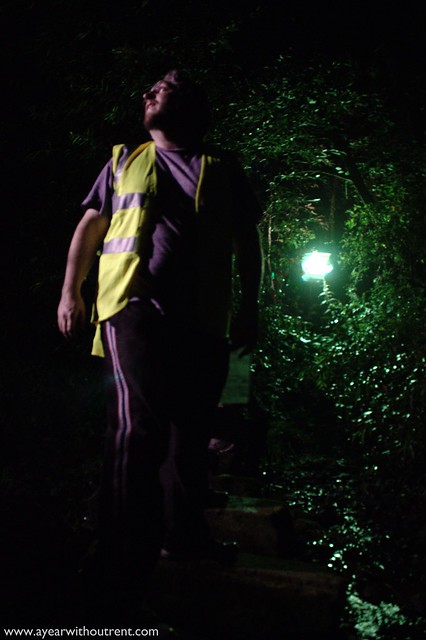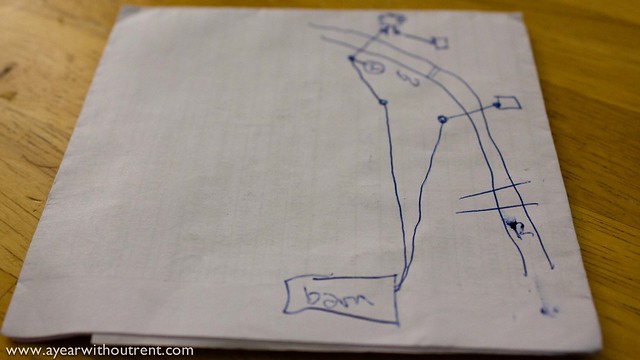
For the first time in A Year Without Rent, I took zero pictures. Yes, zero. You’ll see 2 pictures in this post. Someone else took them.
But why? One word: rain. Well, that and darkness.
For the 3rd day of THE STAGG DO, we move to night shoots, and naturally we don’t have nearly enough lights for what we need to do. Basically we’ve got to light the woods and a field with a 2k and 6 redheads, which are 800W each. Add to that the fact that we’ve got a limited number of extension cords, and basically that means that my day involves trying to figure out just how to maximize our lines so that we can power lights wherever DP Richy Reay needs them.
The extension cords are in drums that have power strips in the middle with either three or four plugs. So those kind of operate as hubs from which we can branch off of. So Ben Moseley and I have a multi-pronged approach where we try and get a hub as far out in the field as possible from the barns, which are roughly 50 meters away from the nearest place we’d put a light.
Each barn has its own circuit, only I have no idea how much power each of them can handle. They’re older buildings, so the suspicion is that there’s only one circuit per barn (there’s two barns close enough). And there’s the math. You want to divide the lights more or less evenly between the two barns.
Then, just when we get them all set up, it starts to rain. First it’s just a drizzle, but it’s enough to be worrisome.
Was it supposed to rain? I don’t know. I can’t use my cell phone in the UK.
The one thing I know about British electricity is that it runs at 240V, as opposed to the U.S., where it’s 120V. That’s a lot. You don’t want to run into that if you don’t have to, and we’ve got it running pretty much all over the place. And it’s raining. I don’t need to tell you how dangerous that is.
This is why we have Runners and PAs.
We’ve got garbage bags and we’ve got tape, so I give it to the runners and 1st AC James Grieves (on load from Richy) and have them cover all of our connections. Keep them dry. Keep them safe. Simple, right?
Five minutes later, I’m about to grab the barrel connectors on the 2k when I notice that the garbage bag isn’t covering the barrels–at all. It’s sort of taped above the barrels, sort of, in a half-assed attempt to look like it should work. Richy is standing a few feet away, so I call him over.
He curses and rolls his eyes as I yell for Jonathan, the runner who yesterday came up so clutch with the burlap sandbags. This won’t work, I tell him. At all. We need to be able to keep the connections dry, so no water will get in there. None. Zero. I tell him I’ll fix this one and then I’m going to start checking the other connections. If they aren’t safe, then I’m going to start cursing at him like he’s never been cursed at before. He’s going to learn some new words. Go. Now.
Then Richy and I give them some extra time. Later in the evening, we’re going to have to move a couple of lights and cables across a small stream and the biggest question of the day is how to do that safely and as quickly as possible. I’ve got a chart I made out the day before and we take a few minutes to talk about how we’re going to do that and where exactly he wants the lights.
[That’s my actual chart, sketched on the back of a call sheet. Yet another reason why you want to give your crew a physical call sheet whenever possible.]
Our AD Jennifer Hegarty is pretty concerned about the move across water. We’ve been talking about it for most of the shoot. My goal is to not only do it safely, but turn it around fast enough that it doesn’t cost the already way behind production any time.
Easier said than done as 5 of our 7 lights are already working and we’re using all of out stingers.
The conversation takes maybe 5 minutes, which I figure gives the runners enough time to have fixed the safety issue, or at least the safety issue at the spot closest to where I’m standing (because, really, that’s the fair place to start looking). Richy and I walk over. What they’ve essentially done is taken some plastic, placed it over the face of one of these, and secured it with gaff tape in the shape of an “X”.
Not exactly what we were looking for.
Richy calls over James, the director. He takes one look at it and, well, expresses his displeasure and pretty much gives me carte blanche to yell at them.
“You know, it’s not even worth doing the film if people are going to get hurt,” he says.
I yell for Jonathan. By now everyone has an idea of what’s going on. And I let him have it with a string of profanities surrounded by the question, “are you trying to get someone killed?” He tries to make a joke out of it, which is a really bad idea, so I yell some more.
He’s not happy. He shouldn’t be.
Am I being unreasonable? Maybe. But the thing is that no matter how collaborative a film project is, there’s a chain of command that operates much like the military. When the Gaffer tells a Runner or Production Assistant to do something (twice), then that damn well should be done better than you think it needs to be, especially when it’s been made clear that the question isn’t of quality but of safety. A film set can be a dangerous place. There’s a lot of ways someone can get hurt. Even so, if you’re a Production Assistant on a film, it doesn’t even matter why someone is telling you to do something. You do it. If you think it’s a dumb request, by all means ask for the reasoning and if the person isn’t a total a*****e (or isn’t completely swamped), they’ll tell you why.
Our reasoning here is pretty simple: IT’S F*****G RAINING.
It’s 240V of electricity. I have no insurance and I’m in Europe. I really don’t want to get electrocuted.
The final solution is to place the drums inside a garbage bag and seal that up with gaff tape, which is a pretty obvious call, really. And maybe I should have suggested that from the beginning, but I thought the task at hand wasn’t very difficult to figure out, so I’ll take some blame for that. But not all of it.
Once we’ve got everything safe, Ben Moseley and I start working on setting the lights for the turnaround across the river. The river is probably 20 feet or so down a pretty steep banking behind the 2k. It’s really small and, let’s face it, not big enough to fish, but that’s what the script calls for, so that’s what we’ll do. We have 2 lights not in play and a couple of gels, but not green ones like we need, so we go back to our grade school color lessons and start mixing and matching what blues and yellows we have to create shades of green.
Having done that, we set the lights. One goes across the river in the woods, more or less directly behind the 2k. It’s about 30 meters in a straight shot, but we can’t do it in a straight shot. We want to keep the wires out of the water (obviously), so we’ve set up a c-stand at the edge of the banking. Earlier in the evening, I put a glow stick on a tree branch across the river, and another one where the light would go. The theory is to string a rope from the c-stand to the tree branch and affix the wires to that, thus keeping it well above the water (and also high enough that no one accidentally runs into it in the dark). The other light goes on the side of the river we’re currently on, but is down an even steeper banking where you have to hold onto tree branches to keep from falling. That’s much easier and as soon as Richy let’s us kill a light in the scene they’re currently shooting, we’ll grab that cable and run it down the banking.
The 2k is gelled blue and operates as our moon, so ideally all we’ll need to do is spin it around. During lunch I’ve added a power strip to the barrel connectors by the 2k, so that we can more easily run power off it without overloading it. Earlier in the evening, we tripped the power, thus realizing that our circuits could handle 3000W each.
They finish the scene in the field well behind schedule. Knowing that James is going to have to rehearse the actors, I make a point of telling him that we’ll be set up before he’s ready. So, like, don’t send them away.
I’m pretty sure he doesn’t believe me. I probably wouldn’t believe me either.
The second they’re done, Ben and I kill the light, rip open the bags around the drums and run over to the river. It doesn’t go as smoothly as we’d like when the rope gets all tangled up and we have to improv but we get it across the river. We’re all ready to go when the bulb goes out in the redhead we just lit.
Besides that, we get it turned around in under 5 minutes. James has briefly sent the actors away, but brings them back to rehearse as Ben changes out the bulb. And it’s a good thing because they finish the scene as the sun comes up.
As for the Electric Company? Well the powers that be decide they should probably wrap up everything. Ben and I bring in the lights and then share wrap beers with Richy while they collect all the cables and trash in the field.
They aren’t too happy with that either. I don’t blame them.
Filmmaker Lucas McNelly is spending a year on the road, volunteering on indie film projects around the country, documenting the process and the exploring the idea of a mobile creative professional. You can see more from A Year Without Rent at the webpage. His feature-length debut is now available to rent on VOD. Follow him on Twitter: @lmcnelly.

